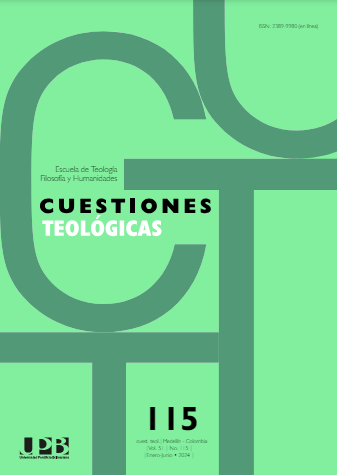The rhetorical device of the “commonplace” (κοινὸς τόπος) in Basil of Caesarea
Main Article Content
Abstract
This paper deals with the resource of the “common place” with the aim of demonstrating the rhetorical invoice used by Basil of Caesarea in two homilies on greed. We proceed in its development through three stages: 1) Disambiguation of “commonplace”, 2) The Greek rhetorical theory and 3) The “commonplace” in Basil of Caesarea. Through these sections, the resource in Greek rhetorical theory is explained and Basil’s mastery of
the structure and its argumentation is verified. To this end, the elaboration is exemplified in “Homilia in illud:
Destruam horrea mea et maiora aedificabo” (HDestr. 7) and “Homilia in divites” (HDiv. 6). The “common place”
is, among the preparatory exercises, one of the most complex in terms of discerning the places of argumentation,
which is why we rely on the rhetorical theory of the Progymnasmata, which facilitates understanding by its
simplicity and speeds up the comparison of structures in both profane and Christian thought. In turn, the
ancient rhetoricians prove to us that the “commonplace” is equivalent to an amplification.
The comparative tables summarize, in an overall view, the results that certify that, although each homily is of
a different style, the schemes of the rhetors Theon and Pseudo Hermogenes prevail, and at the same time they
evidence the originality of the orator. There are no rhetorical studies of this resource on our author, so we hope that this contribution will give rise to similar writings.
References
Aelius Theon. (1997). Progymnasmata (M. Patillon y G. Bolognesi, Trads.). Paris: Les Belles Lettres.
Anaxímenes de Lámpsaco. (2005). Retórica a Alejandro (M. A. Márquez Guerrero, Trad.). Madrid: Gredos, Biblioteca Clásica Gredos 341.
Aristóteles. (1999). Retórica (Q. Racionero, Trad.). Madrid: Gredos, Biblioteca Clásica Gredos 142.
Basile, S. (1935). Homélies sur la richesse (Y. Courtonne, Ed. y Trad.). Paris: Firmin-Didot.
Basile de Cesarée. (1968). Homélies sur l’Hexaémeron (S. Giet, Ed. y Trad.). Paris: Éditions du cerf, Sources Chrétiennes 26 bis. Basilio de Cesarea. (En prensa). Homilías diversas (Ma. A. Valdés García, Trad.). México: Universidad Nacional Autónoma de México, Aproximación a la Patrística.
Basilio de Cesarea. (2007). Panegíricos a los mártires. Homilías contra las pasiones (Ma. A. Valdés García, Trad.). Madrid: Ciudad Nueva, Biblioteca de Patrística 73.
Cicerón. (1948). De los deberes (B. Estrada Morán, Trad.). México: Universidad Nacional Autónoma de México, Bibliotheca Scriptorum Graecorum et Romanorum Mexicana.
Cicerón. (2001). El orador (E. Sánchez Salor, Trad.). Madrid: Alianza, Biblioteca Temática 8246.
Cicerón. (1997). La invención retórica (S. Núñez, Trad.). Madrid: Gredos, Biblioteca Clásica Gredos 245.
Cicerón. (1924). Particiones oratorias (M. Menéndez Pelayo, Trad.). Madrid: Sucesores de Hernando.
Cicerón. (2002). Sobre el orador (J. J. Iso, Trad.). Madrid: Gredos, Biblioteca Clásica Gredos 300.
Colson, F. H. (1921). Quintilian I, 9 and the Chria in Ancient Education. Classical Review, 35(7-8), 150-154.
Courtonne, Y. (1935). “Homélie sur cette parole de l’Évangile sélon s. Luc ‘Je détruirai mes greniers et j’en construirai de plus grands’ et sur l’avarice”. “Homélie contre les riches” en Saint Basile. Homélies sur la richesse (pp. 14-71). París: Firmin-Didot.
Deligiorgis, S. (1971). The Auxetic Mode in Ancient Rhetorical Theory and Practice. Platon, 23, 311-318. http://www.grissh.gr/system/articles/assets/5c45/97a8/5574/4117/a400/006c/original/PLATON_QR6217-17.pdf?1548064680
Fruteau de Laclos, H. (1999). Les progymnasmata de Nicolaos de Myra dans la tradition versicolore des exercises preparatoires de rhetorique. Montpellier: Université Paul Valéry.
Goyet, F. (1996). Le sublime du “lieu commun”. L’invention rhétorique dans l’Antiquité et à la Renaissance. Paris: Honoré Champion.
Hermógenes. (1991). Sobre el método de tipo fuerza (A. Sancho Royo, Trad.). Sevilla: Secretariado de Publicaciones de la Universidad de Sevilla, Serie Filosofía y Letras.
Kennedy, G. A. (1963). The Art of Persuasion in Greece. London: Routledge and Kegan Paul.
Kennedy, V. R. (1971). Auxesis. A Concept of Rhetorical Amplification. Southern Speech Communication Journal, m37(1), 60-72.
Lavency, M. (1965). La technique des lieux communs de la rhétorique grecque. Les Études Classiques, 33(2), 113-126.
Longino. (1979). Sobre lo sublime (J. García López, Trad.). Madrid: Gredos, Biblioteca Clásica Gredos 15.
Malosse, P. L. (2000). La pratique concrète de l’amplification dans la rhétorique ancienne. Revue de Philologique, de Litterature et d´Histoire anciennes, 74(1-2), 179-198.
Menandro el rétor. (1996). Dos tratados de retórica epidíctica (M. García García y J. Gutiérrez Calderón, Trads.). Madrid: Gredos, Biblioteca Clásica Gredos 225.
Mertner, E. (1956). Topos und Commonplace. In G. Dietrich and F. W. Schulze (Dirs.). Strena Anglica (pp. 178-224). Halle: M. Niemeyer.
Navarre, O. (1900). Essai sur la rhétorique grecque avant Aristote. Paris: Hachette.
Nervo, A. (1991). Obras completas (Vol. 2). Madrid: Aguilar, Grandes Clásicos.
Nicolaus. (1913). Progymnasmata. Rhetores Graeci (Vol. 11, I. Felten, Ed.). Leipzig: Teubner.
Oltramare, A. (1926). Les origines de la diatribe romaine. Laussane: Payot.
Pernot, L. (1986). Lieu et lieu commun dans la rhétorique antique. Bulletin de l’Association Guillaume Budé, (3), 253-284. https://www.persee.fr/doc/bude_0004-5527_1986_num_1_3_1308
Quintiliano. (1999). Obra completa (Vol. 3, A. Ortega Carmona, Trad.). Salamanca: Publicaciones Universidad Pontificia de Salamanca-Caja Duero.
Reichel, G. (1909). Quaestiones progymnasmaticae (Diss.), Leipzig: Robert Noske.
Retórica a Herenio (1997) (S. Núñez, Trad.). Madrid: Gredos, Biblioteca Clásica Gredos 244.
Teón, Hermógenes y Aftonio. (1991). Ejercicios preparatorios (M. D. Martínez Reche, Trad.). Madrid: Gredos, Biblioteca Clásica Gredos 158.
Thionville, E. (1983). La théorie des lieux communs dans les Topiques d’Aristote et des principales modifications quelle a subies jusqu’a nos jours. Paris: J. Vrin.
Volkmann, R. (1963). Die Rhetorik der Griechen und Römer in Systematischer Übersicht. Hildesheim: Olms






